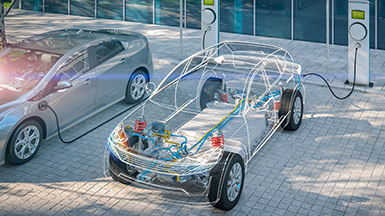

Signals+ ニュースレター登録
Signals+はコネクティビティ、デジタルヘルス、モビリティ、スマートインダストリーに関する最新情報をお届けします。
ありがとうございます。ご登録のメールアドレスにお送りしたメールを確認し、ニュースレター登録を完了させてください。
世界中の人々の生活に影響を与える、画期的なテクノロジーに関する最新情報をタイムリーにお届けします。
閉じるTOKYO OLYMPICS: GOLD STANDARD FOR ELECTRIC VEHICLES AND AUTONOMOUS VEHICLES
The Tokyo Olympics won’t just be a worldwide display of the finest athletes on the planet—sharing center stage will be the future of transportation as we know it. Toyota is organizing transportation for athletes with electric vehicles (EV) and autonomous vehicles—buses, minivans, SUVs, and sedans—throughout the Olympics to transport athletes around the Olympic Village.
This will be an exciting, real-world technological showcase that also points to a sea change taking place beyond the Sea of Japan. The world of transportation is fundamentally and forever changing. In fact, Japan’s government and car industry are implementing an autonomous driving vehicle and infrastructure support plan. The reasons for this ambitious plan are threefold: reduce road fatalities; reduce traffic congestion and exhaust emissions; and create a public transport network that caters to Japan’s aging population, 25% of which will be over 65 by 2025.
But while all this bodes well for a truly sustainable future of transport with visions of environmentally conscious initiatives (EVs) and safer, less accident-filled highways (Autonomy), there are still some challenges standing in the way of this transportation utopia.
POWERING A SUSTAINABLE FUTURE

While watching all those powerful feats of athletic prowess at the Olympics, another power feat generated by those EVs and AGVs will be on display buzzing around the Olympic Village.
Power management is one of the leading challenges faced by industry leaders, and overcoming it will play a substantial role in limiting energy consumption from the grid and reducing the global carbon footprint. It’s predicted that by 2050 there will be an estimated increase of 60% in the worldwide demand for energy.1 EVs and AGVs will undoubtedly be at the forefront of this demand.

“The rapid advancements across the automotive market in electric vehicles, digital in-cabin experience, and autonomy are bringing about an excitement not felt in the industry for decades. As these innovations converge, we must not forget about efficient power management to ensure these capabilities arrive sustainably and without impacting vehicle performance.”Greg Henderson
オートモーティブ、通信、航空宇宙/防衛担当シニア・バイス・プレジデント | アナログ・デバイセズ
EVs and AGVs hold the promise of lowering carbon dioxide emissions dramatically, but their power consumption and development of their energy (battery cells, etc.) will be a challenge. Leading the charge in addressing this challenge and struggle between performance and sustainability will be power semiconductors. Innovations for higher efficiency, smaller size, lower noise, and better system intelligence will be critical enablers of a more sustainable future.
ACCELERATING TO FULL EV ADOPTION

The Olympics will focus the world’s attention to the EV renaissance, with electric vehicle adoption rates soon reaching a tipping point across the globe. In fact, in a recent Bain survey of consumers from the U.S., Germany, and China, almost 50% said they are considering purchasing an electric vehicle as their next car.2
But in order to expand the market based on consumer demand, shoppers will need to feel assured that owning an electric vehicle can cost the same as, if not less than, a gasoline-powered vehicle. This will ultimately depend on the total cost of ownership (TCO). But progress is definitely occurring as evidenced by the fact the Tesla Model 3 and Ford F150 both have similar costs (about $40,000).
In fact, an MIT study found that when operating and maintenance costs are factored into a vehicle’s price, autos emitting less carbon (including EVs) are among the market’s least expensive options, on a per-mile basis.3
THE COST OF DISCARDED BATTERIES IS GROWING
Batteries remain the major area of focus for electric vehicle cost efficiencies. Batteries are the heart of the electric vehicle and can make up between 25% to 30% of the total cost of an EV. But marked improvements are in store: significant advancements in battery chemistry and electronics are driving down costs and enabling efficient battery reuse and second life, which could deliver the cost advantages needed to push EV adoption past the tipping point.
Efficient battery health monitoring throughout a battery’s first life, and any subsequent lives, will help build trust between battery buyers and sellers. This trust will allow batteries to be treated as an asset that OEMs can use to recoup some of their initial battery investment and potentially pass that savings on to consumers.

By 2040 there could be ~8M metric tons of EV batter waste – roughly the mass of the Great Pyramid of Giza.
AUTONOMOUS VEHICLES PUT SAFETY IN THE DRIVER'S SEAT

While Toyota’s Olympic mobility display will showcase the future promise of EVs and autonomous vehicles, the transition of gas-powered vehicles to EVs is well under way. The next logical step in this transportation evolution is autonomous vehicles.
There actually is some movement in the autonomous front going on right now as Google’s Waymo operates an autonomous driving (AD) taxi service in Arizona; Daimler is testing autonomous trucks in Southwest U.S.; and Amazon has contracted Rivian to produce 100,000 electric delivery vans by 2030, with the first 10,000 hitting the road by the end of 2022.
But unlike EVs’ adoption point, automated guided vehicles’ large scale adoption point is not expected to arrive until well into 2030 and beyond. One of the biggest hurdles factoring into this slow adoption remains safety. People are not going to be driven around by a driverless vehicle without some basic assurances of safety. It seems ironic, since studies have shown that almost 94% of car accidents are the result of human error.4
As demand for increasing levels of automotive autonomy continues to grow, it has become paramount that applications develop a level of situational awareness and human-like sensing to not only protect people and assets, but also to provide greater freedom, flexibility, and productivity to businesses and consumers alike.
Perception and navigation sensing enable the vehicle to see the world around it and feel the movement of the vehicle, much like a human operator would. Only through a robust and reliable sensor fusion solution that combines modalities like radar, LIDAR, cameras, inertial, and global navigation satellite system (GNSS) will unmanned and autonomous vehicles be able to discern their environment accurately enough to outperform human operators.
SEE HOW ADI IS SHAPING THE FUTURE OF MOBILITY
Click on the interactive graphic above to review how ADI’s technologies create an immersive in-cabin experience. Expand this window in the lower right corner for easier viewing.
THE CONNECTED CAR: DIGITIZED, PERSONALIZED, & IMMERSIVE

While autonomous and electric vehicles continue to make headlines, in-cabin comforts and an immersive experience remain significant for consumer purchase decisions. Automotive is fast becoming more of a consumer-driven industry than ever before, and all consumer industries are driven by customer experience. Today, the digital cabin experience is one of the most important purchasing criteria when buying an automobile. In fact, many consider the car is the next mobile infotainment platform and a seamless extension of our connected lives. Easy customization and upgradeability are key to offering new features and services, which have become an important element of the car buying decision.
Immersive Audio
For most people, the highest performance audio system they own actually lives within their personal vehicle. Audio systems now feature up to 20+ speakers for total surround sound. Manufacturers are leveraging trends from within home theater systems to bring this immersive experience to the road.
A quieter cabin doesn’t just provide a more robust audio experience, it can help with the driving experience since noise within the cabin is one of the leading factors of driver fatigue over long distances. So as we transition to electric vehicles, the in-cabin experience becomes even more critical as there is no engine noise to mask the road noise coming into the vehicle. Therefore, the next step in noise cancellation will come in the form of personal audio zones. This concept is quite complicated as it brings noise cancellation techniques within the cabin itself to cancel surrounding, in-cabin noise and provides a personalized sound bubble for each occupant of the vehicle. Much of the focus for EVs has been on range and charge time, which are critical, but we can’t forget the importance of the in-cabin experience to the overall mobility experience.
Software Experience
The future car will be as much about software as it is about engine and body style. Much like a phone, future cars could update overnight like Tesla does now. This automotive, SaaS-like functionality would almost eliminate the need for a new car every 3 to 5 years as most people would need to just hit “update” on their car’s operating system and boom: new car. Of course, to appease those who always want the latest and greatest, there might need to be a new car smell update as well!
DRIVING A MEMORABLE OLYMPIC PERFORMANCE

Looking back on this year’s Olympics, you might well remember it as an epic event, not so much in the field of athletics, but rather by the fact you witnessed the future of transportation rolled out on a global stage—in the form of electric vehicles and autonomous guided vehicles.
Electric vehicles are currently proliferating across the globe and will soon pass the tipping point of mass adoption, while truly autonomous vehicles—not just commercial, but consumer-specific vehicles—are still on the horizon, but fast approaching. Before this exciting new world of humanistic transportation can become ingrained in our society, a few key points need to be considered in the build up to adoption, including power management, software configuration, battery electronics, and overall environmental sustainability.
Living at the heart of these technologies is what’s made ADI a leader across the automotive industry: intelligence, skill, experience, and ingenuity.
References
1EIA projects nearly 50% increase in world energy usage by 2050, led by growth in Asia - Today in Energy - U.S. Energy Information Administration (EIA)
2Electric and Autonomous Vehicles: The Future Is Now | Bain & Company
3Study: Low-emissions vehicles are less expensive overall | MIT News | Massachusetts Institute of Technology
4NHTSA: Nearly all car crashes are due to human error | Ayers, Whitlow & Dressler



